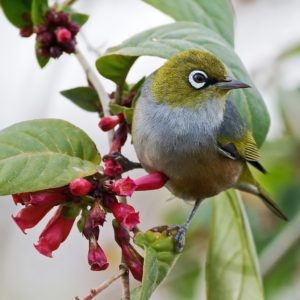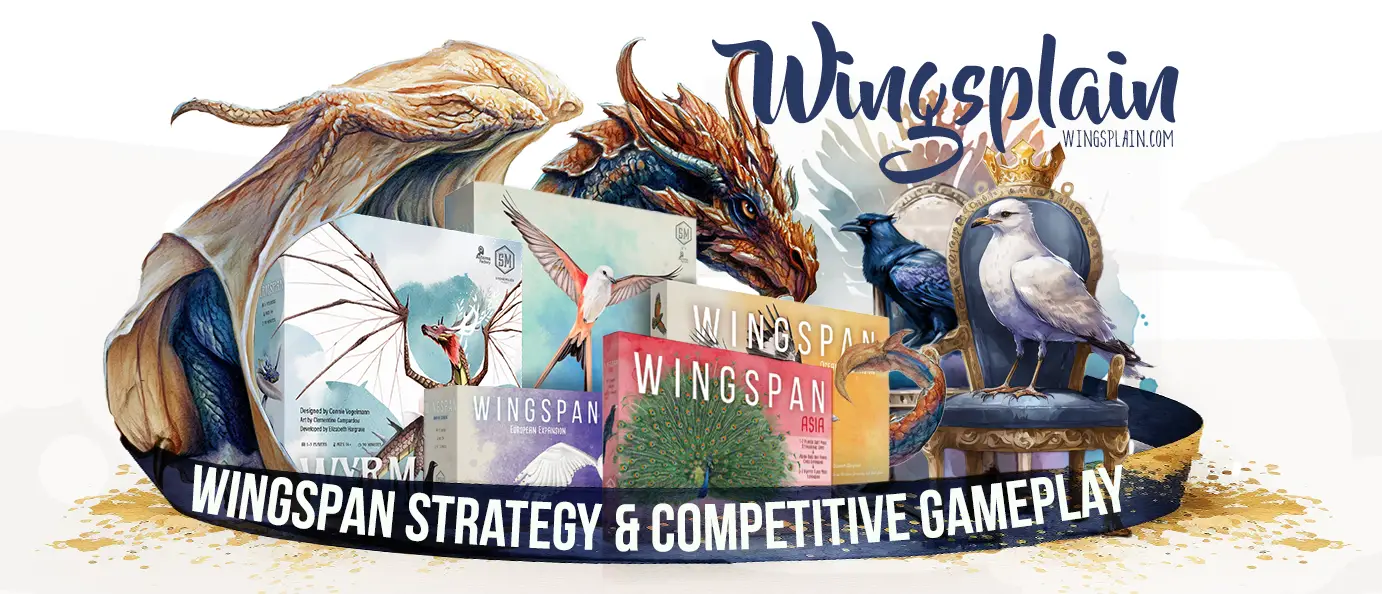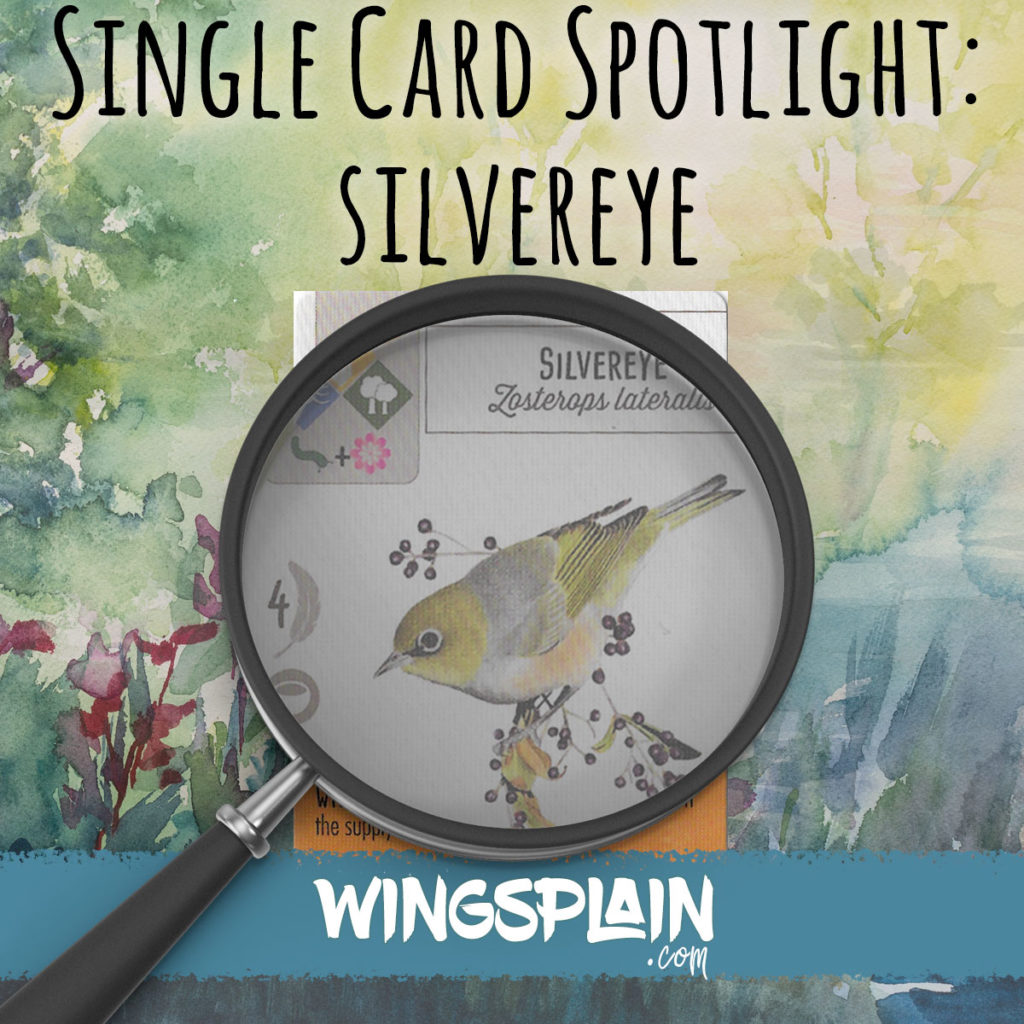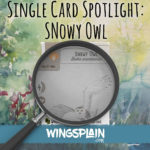Silvereye Card Details
Set: Oceania Expansion
Habitat: All
Food Cost: Worm + Nectar
Points: 4
Nest Type: Cup
Nest Capacity: 4
Power: When Activated: All players gain one nectar from the supply.
Optimal Use of Silvereye in Wingspan
This bird has a moderate food cost and enjoys the flexibility of being playable in all habitats. This is especially useful for providing an “off habitat resource” in the Grasslands and Wetlands, specifically, Nectar from the supply. The drawback is that everyone gets this nectar, so you have to weigh the risk vs. reward of giving your opponents access to this wild food resource as well.
As with any card that gives something to your opponents, careful monitoring of the game state is required. If you aren’t at least breaking even in the transaction, don’t give this to your opponents.
The best uses of this bird’s brown power will be as a part of an early Grasslands or Wetlands engine where it pretends to be a Hummingbird. You’re getting eggs and wild food in the Grasslands, so you have everything you need to play more birds, as long as you have the cards in your hand. From the Wetlands, you have wild food and plenty of bird options in hand to play, but eggs will be in shorter supply.
Anytime you are giving resources to your opponents, you should be looking for ways to mitigate that drawback. There are several other birds that combo well with Silvereye.
Pesquet’s Parrot (PP) and Kereru (KR) both look for nectar in an opponent’s supply (the player to the right or left, respectively). If your Silvereye gives nectar to everyone, PP and KR will net you another nectar, giving you two-to-one on that exchange (or three-to-one in the rare occurrence that you have all three on the board).
It should be noted that these two complimentary birds are restricted to the forest. The combo is best while they are a part of the same Forest engine (not necessarily the best habitat for the Silvereye). If Silvereye is outside the Forest, you will have to wait until your next activation to take the Gain Food action and “punish” your opponent for receiving that free nectar. This allows them to spend it and deny you that opportunity.
As a part of a Wetlands engine, Black Headed Gull supports Silvereye by stealing the nectar that was given to an opponent. The victim gets to claim a die from the birdfeeder, so they might just end up replacing that nectar. Even so, the Gull is still allowing you to get nectar two-to-one over your opponents in this situation. The target of the Gull might even get unlucky, and there won’t be any nectar in the birdfeeder.
Moving on from its power, this tri-habitat bird is worth four victory points and has a four egg cup nest. Not great, but not bad. If you’re playing this bird early in the Grasslands and you plan to expand that out, you’re going to appreciate that four egg nest. If you don’t have room in your Grasslands engine, Silvereye can be a good Forest/Wetlands drop for extra egg capacity.
Silvereye qualifies for a decent amount of bonus cards. Food Web Expert tacks two points onto this bird. Anatomist has a low point of entry at two birds, and Silvereye gets you halfway there.
Fun Facts About the Silvereye Bird
 Silvereyes are also known as Wax-eyes. This is because of the white ring of feathers they have around their dark eyes. Its common name is sometimes White-eye in Australia and New Zealand.
Silvereyes are also known as Wax-eyes. This is because of the white ring of feathers they have around their dark eyes. Its common name is sometimes White-eye in Australia and New Zealand.
Because they like to feed on fruit and nectar, they are sometimes regarded as pests to some commercial orchards.
Most of the Tasmanian population crosses the Bass Strait and disperses into Victoria, New South Wales, and South-Eastern Queensland.




Surely this bird doesn’t qualify for food web expert. It eats nectar as well as invertebrate
Thanks for pointing that out, Sam. You’re right, I’ll have to correct that. It’s easy to make that mistake I think because all of the other food based bonus cards just need that one food type included in the bird’s cost. Food Web Expert is only invertebrates.
I like this idea of individual birds showcase, pretty cool.
Another way to mitigate the impact of distributing nectar is to have round end power that can use it, such as YellowHammer or Common Starling. This just means that you can gain nectar on the last turn of a round when other players might be in a position where they cannot use it and have to throw it away at the end of the round.
Unfortunately the Silvereye seems to be the worst of the bunch. Hummingbirds, Bluethroat and Common Nightingale being generally better for the same role. Food cost that forces a nectar is also sub-ideal, the Eastern Roselia is faced with a similar problem but does provide you with two food instead of one.
honestly i’d probably just play this card because of the bird